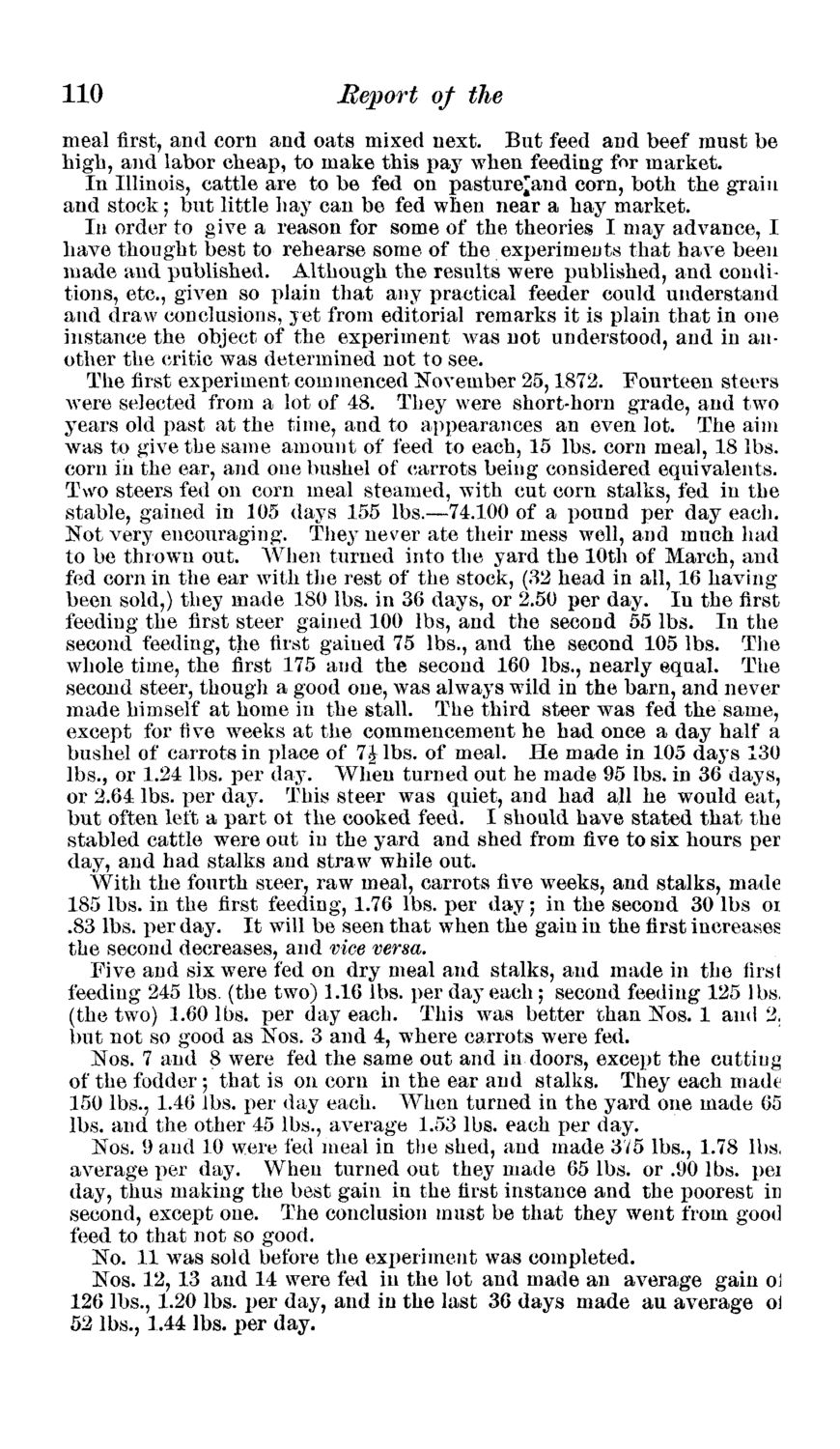| |
| |
Caption: Board of Trustees Minutes - 1874
This is a reduced-resolution page image for fast online browsing.

EXTRACTED TEXT FROM PAGE:
110 Report of the meal first, and corn and oats mixed next. But feed and beef must be high, and labor cheap, to make this pay when feeding for market. In Illinois, cattle are to be fed on pasture'and corn, both the grain and stock; but little hay can be fed when near a hay market. In order to give a reason for some of the theories I may advance, I have thought best to rehearse some of the experiments that have been made and published. Although the results were published, and conditions, etc., given so plain that any practical feeder could understand and draw conclusions, j e t from editorial remarks it is plain that in one instance the object of the experiment was not understood, and in another the critic was determined not to see. The first experiment commenced November 25,1872. Fourteen steers were selected from a lot of 48. They were short-horn grade, and two years old past at the time, and to appearances an even lot. The aim was to give the same amount of feed to each, 15 lbs. corn meal, 18 lbs. corn in the ear, and one bushel of carrots being considered equivalents. TVo steers fed on corn meal steamed, with cut corn stalks, fed in the stable, gained in 105 days 155 lbs.—74.100 of a pound per day each. Not very encouraging. They never ate their mess well, and much had to be thrown out. When turned into the yard the 10th of March, and fed corn in the ear with the rest of the stock, (32 head in all, 16 having been sold,) they made 180 lbs. in 36 days, or 2.50 per day. In the first feeding the first steer gained 100 lbs, and the second 55 lbs. In the second feeding, the first gained 75 lbs., and the second 105 lbs. The whole time, the first 175 and the second 160 lbs., nearly equal. The second steer, though a good one, was always wild in the barn, and never made himself at home in the stall. The third steer was fed the same, except for ijvQ weeks at the commencement he had once a day half a bushel of carrots in place of 7 J lbs. of meal. He made in 105 days 130 lbs., or 1.24 lbs. per day. When turned out he made 95 lbs. in 36 days, or 2.64 lbs. }3er day. This steer was quiet, and had all he would eat, but often left a part ot the cooked feed. I should have stated that the stabled cattle were out in the yard and shed from five to six hours per day, and had stalks and straw while out. With the fourth steer, raw meal, carrots five weeks, and stalks, made 185 lbs. in the first feeding, 1.76 lbs. per day; in the second 30 lbs oi .83 lbs. per day. It will be seen that when the gain in the first increases the second decreases, and vice versa. Five and six were fed on dry meal and stalks, and made in the first feeding 245 lbs. (the two) 1.16 lbs. per day each; second feeding 125 lbs, (the two) 1.60 lbs. per day each. This was better than Nos. 1 and 2. but not so good as Nos. 3 and 4, where carrots were fed. Nos. 7 and 8 were fed the same out and in doors, except the cutting of the fodder; that is on corn in the ear and stalks. They each made 150 lbs., 1.46 lbs. per day each. When turned in the yard one made 65 lbs. and the other 45 lbs., average 1.53 lbs. each per day. Nos. 9 and 10 were fed meal in the shed, and made 3/5 lbs., 1.78 lbs, average per day. When turned out they made 65 lbs. or .90 lbs. pei day, thus making the best gain in the first instance and the poorest in second, except one. The conclusion must be that they went from good feed to that not so good. No. 11 was sold before the experiment was completed. Nos. 12, 13 and 14 were fed in the lot and made an average gain oi 126 lbs., 1.20 lbs. per day, and in the last 36 days made au average oJ 52 lbs., 1.44 lbs. per day.
| |